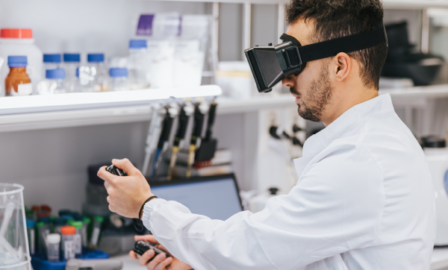2025 Medical Device Industry Trends
Clarkston’s team of life sciences consultants have highlighted the top medical device industry trends that businesses should consider. See an excerpt of the trends report below, and read all five trends for 2025 by downloading the full report here.
2025 Medical Device Industry Trends
As we move into 2025, the medical device industry continues to push the boundaries of innovation. Patients and healthcare providers alike are driving demand for smarter, more precise, and highly integrated technologies that enhance both treatment and patient experience.
In the coming year, we expect to see groundbreaking advancements in brain-computer interfaces, which are now entering early-stage human trials, as well as significant progress in robotics, expanding the capabilities of robot-assisted laparoscopic surgeries. Artificial intelligence (AI) and machine learning (ML) will play an even greater role in medical device software, while immersive technologies like virtual and augmented reality will reshape medical training and patient care. Additionally, 3D printing is making strides in personalized medicine, allowing for the creation of customized implants and prosthetics. This report explores these five key trends that will shape the medical device industry in 2025 and beyond.
Trend #1: Brain-Computer Interfaces
Brain-computer interface (BCI) technology has been making more noise over the past year, as early clinical studies of invasive interfaces have generated positive press and more is to come in 2025. BCI technology helps direct communication between the brain and external devices. Artificial Intelligence (AI) is often embedded in these medical devices.
In 2025, BCI technology is expected to advance in many ways, including increased use for assistive technologies, treatment of neurological disorders, neuro-prosthetics, cognitive training and neurorehabilitation.
Neurological disorders like Parkinson’s disease, Alzheimer’s, epilepsy, and spinal cord injuries may be improved using BCI technology. AI-driven BCIs can help patients with locked-in syndrome and neurodegenerative diseases regain mobility and communication.
BCI neuro-prosthetic devices are helping paralyzed individuals regain movement via brain-controlled wheelchairs, robotic limbs, and speech assistance devices. BCI-powered exoskeletons and robotic prosthetics are giving hope to patients with severe motor disabilities, allowing them to regain movement with the power of thought.
BCIs also help in cognitive rehabilitation and neurorehabilitation, allowing patients to recover from debilitating conditions such as stroke or traumatic brain injuries. Researchers are developing personalized solutions that use BCIs to monitor brain activity in real time and adjust rehabilitation exercises accordingly. This customized approach helps patients recover motor functions faster, improving their quality of life.
There are market challenges with BCIs such as prohibitive cost, limited access, complex regulatory hurdles, technical issues, and ethical concerns.
Trend #2: Medical Robots
Robotics will enhance precision in surgeries and rehabilitation, improving patient outcomes for more people with increased competition entering the market in 2025. Medical robot-assisted surgery has been slowly replacing conventional surgical methods for the past 25 years with the Intuitive Surgical da Vinci robot owning the market. Robots are now routinely used in many laparoscopic soft tissue procedures, including cardiac, urologic, gynecologic, and general surgery for better targeting and patient safety. These surgeries ensure that patients undergo smaller incisions, less blood loss, and recover faster while the surgeons receive help from improved ergonomics and dexterity in comparison to traditional laparoscopy.
Now, dozens of newcomers are pursuing niche applications of robotics in surgery. Medtronic is in a strong second place with their Hugo robot. Other players include Johnson & Johnson, CMR Surgical, Distalmotion, Virtual Incision, Moon Surgical, Medical Microinstruments, Procept Biorobotics, Stryker and Zimmer Biomet. MEDTECHDIVE reported that 10 years from now, Intuitive is expected to have 70% of the market with Medtronic and Johnson & Johnson each having 10%. All other firms will account for the remaining 10% market share.
There are also many applications for medical robotics outside the surgical suite. We will discuss two examples:
- First is RIF Robotics, who created a robotic system that automates surgical tray preparation. This system uses computer vision and robotics to identify, inspect, and handle surgical instruments.
- Second is BioBOTs by Theranautilus, which are specialized magnetic nanobots laced with bioactive components used to permanently treat hypersensitivity and promote tooth regeneration.
- According to a report by Mordor Intelligence, the Medical Robotic Systems Market size is expected to reach $28.14 billion by 2029, growing at a CAGR of 16.13 per cent during the forecast period (2024-2029).
Continue reading by downloading the full report below.
Download the Full 2025 Medical Device Trends Report Here
Read last year’s Medical Device Industry Trends Report here.




